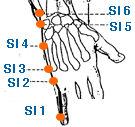SI 1
Acupuncture Point Theory
SI 1 Acupuncture Point Applications and Theory
 The acupuncture point "SI 1" , 少澤, is represented by "Shao Ze" in pinyin and "Lesser Marsh" in english and may be found:
The acupuncture point "SI 1" , 少澤, is represented by "Shao Ze" in pinyin and "Lesser Marsh" in english and may be found:
.1 cun posterior to the corner of the nail on the ulnar side of the little finger.
Of many possible clinical applications, it may be considered to influence the following issues/symptoms:
- Breast disorders of any etiology, insufficient lactation, mastitis, breast abscess, cysts.
- Jing Well Point, clear heat from the opposite end of the channel, for eye redness, earache, tinnitus, sore throat, stiff tongue.
- Headache, dizziness, loss of consciousness.
- Local point for problems of the little finger and the course of the channel - pain and/or weakness of the arm and/or shoulder.
Si 1 has the following theoretical associations which serve as important guideposts in designing an effective treatment protocol:
- Jing Well Point
- Metal Point
- Entry Point
Explore si 1 functional groupings theory - Entry Exit Point and/or Five Shu, or read all point categories and related theory.
A single acupuncture point is not commonly thought of as an empirical way to influence a TCM diagnostic pattern. SI1, however, is a strong candidate to be incorporated into an acupuncture protocol for patients who exhibit: Liver Fire
SI 1 may potentially be used, in coordination with a well designed acupuncture treatment protocol, to influence the following conditions: Arm Pain, Breast Cancer, Breast Distention, Cysts, Dizziness (Vertigo), Ear Problems, Eye Problems, Fainting (Loss of Consciousness), Headache, Insufficient Lactation, Mastitis, Sore Throat and/or Tinnitus
While not necessarily valid clinically, HT 9 (Jing Well Point - clear heat a/or obstruction fro…) and TH 1 (Similar to TH 3 which is used more clinically. ) are nearby.
All Content 1999-2025
Chad J. Dupuis / Yin Yang House
Our Policies and Privacy Guidelines
Our Affiliated Clinics
